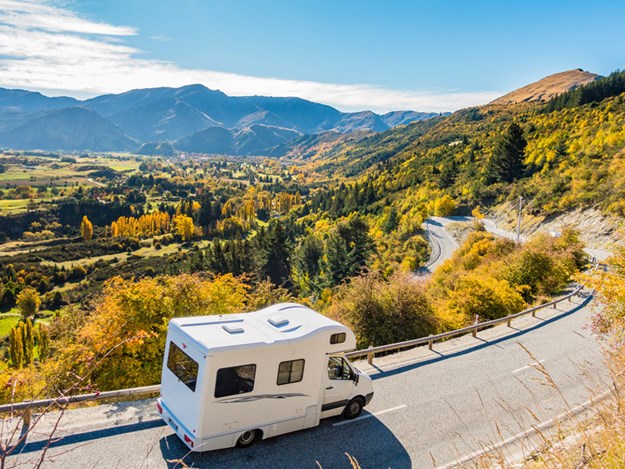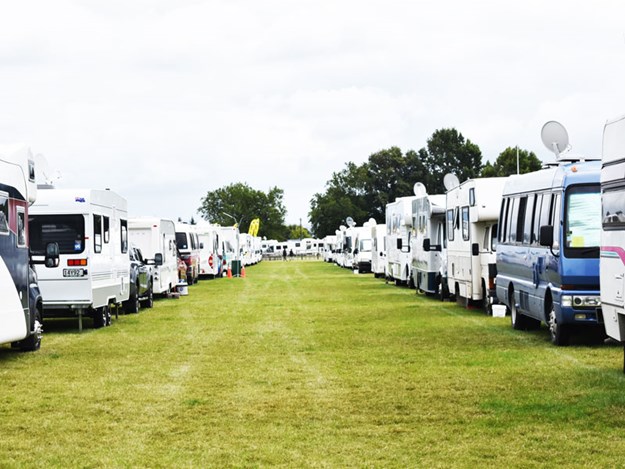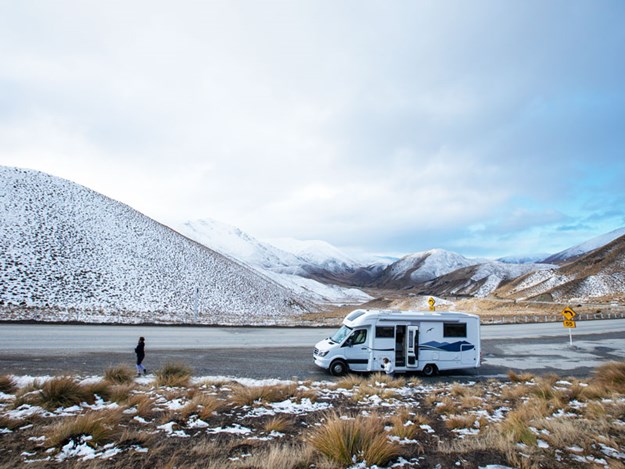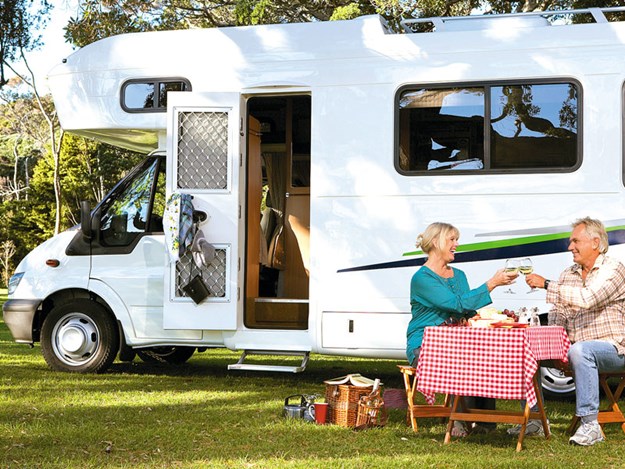New Zealand is known internationally as the land of the motorhome holiday. The scenery is spectacular, the locals friendly and it’s only a few 100km between the east and west coasts. It’s no wonder so many tourists view Aotearoa as the ultimate destination for that once-in-a-lifetime driving holiday.

So why not New Zealanders? In the spirit of “don’t leave home until you’ve seen the country”, here’s a beginner’s guide to motorhoming for any Kiwi considering a holiday on the road.
Why choose motorhoming?
Motorhomes are popular because they provide the freedom and flexibility to explore at your own pace. The trend is on the rise as more and more locals catch on to the international hype.
Over the past few years, there has been a 50 per cent increase in new motorhome registrations. Motorhoming offers so much more than just booking a bach and staying in one place, or exploring one overseas holiday destination each year. Motorhoming is exploring new towns, regions and activities wherever and whenever.
Where can I go with a motorhome?

New Zealand legislation protects our ability to freedom camp, known in motorhome lingo as “certified self-contained” camping. When a motorhome is suitably certified according to New Zealand Motor Caravan Association (NZMCA) criteria, you can park almost anywhere safely, legally and comfortably.
The NZMCA has a list of motorhome-friendly towns that helps you plan your journey. There are more than 45 towns throughout the country committed to allowing and providing the resources for happy, self-contained camping in some of the most picturesque locations in the world.
What is “certified self-contained”?
Some 80,000 international visitors to New Zealand a year to take advantage of its fantastic landscape and the ability it offers to freedom camp. But what exactly are the rules and regulations? And how do you keep yourself and your family on the right side of them?
Freedom camping means staying at a place that is not an official campsite, in a tent, caravan, campervan or motorhome. It’s a great way to explore, and it’s perfectly legal as long as you are certified self-contained. The NZMCA sets a basic standard for self-containment.
But the reality of how we use a motorhome and what’s required from a specification point of view is quite a bit higher than the basic criteria. Make sure your new motorhome meets the NZMCA self-containment criteria so it can be awarded the certifying blue sticker.
The basic criteria are:
- Sink
- Water supply (12L per person minimum). From survey results of motorhome users, the average daily consumption of water per couple is 40L to 50L per day.
- Toilet (3L sewage tank capacity per person) – useable when the bed is fully made up.
- Holding tank (same or larger volume than freshwater).
- Evacuation hose.
- Approved waste tank treatments.
- Sealable refuse container (with lid).
Find out more about the criteria at nzmca.org.nz.
What are the costs of motorhoming?
Overall, there are huge variables in the budget attached to motorhoming, even if the running of them is relatively cost-effective. It depends on how much you, as the user, have to spend upfront and also during the journey. Here are some basic things to consider:
Accommodation
If your motorhome is suitably self-contained, you can avoid the need to pay for campgrounds, which can range from $20 to $100 a night, and use a low-cost or free option most of the time. Best case scenario, accommodation is free. However, there are beautiful NZMCA POP (Park Over Property) and DOC camping sites that are low cost or request a donation of anywhere between $2 and $10.
Fuel
Most new motorhomes are built on European or Japanese chassis on vehicles with easily recognisable brand names. Since the introduction of fuel-consumption ratings in the 1990s, turbo functionality and the rise in motor technology has drastically increased efficiency.
A motorhome is heavier than a standard car and fuel consumption varies hugely. You can expect an range of anywhere between 13L to 22L per 100km. Tank sizes are all approximately 100L, and diesel is by far the best, most economical fuel option.
Many dealers won’t even consider a petrol motorhome for trade or resale. You could probably drive the whole length of New Zealand in a motorhome for less than the cost of an average grocery shop.
When can I travel?

In a recent industry survey, results showed that 44 per cent of motorhome owners travel monthly or more often, proving that the beauty of modern day motorhoming is that you really can go year-round.
You certainly don’t need to avoid travelling in the winter when some New Zealand scenery can be at its most picturesque. A good-quality motorhome will be designed for touring 12 months of the year and include creature comforts that allow that to happen, such as:
- diesel or gas heating;
- insulated walls, ceilings, floors or all of the above;
- double-glazed windows;
- diesel electric or gas hot-water systems;
- traction control;
- light and rain sensors;
- thermal blinds;
- heater ducts in the bathroom.
A self-contained motorhome also ensures that summer motorhoming is at its most enjoyable when you can choose locations that suit your tastes for adventure.
Where do I start when buying a motorhome?
Researching and deciding on a new lifestyle choice can be quite overwhelming, but it doesn’t need to be. There are some simple steps to take to make sure you make the right decision:
- Read blogs, explore destinations and get a firm handle on what motorhoming is and what it isn’t to decide whether it’s something that you would enjoy.
- Understand that the average time spent researching before buying a motorhome is five months.
- Be very clear on how you are going to use your motorhome. This markedly improves your chances of a successful purchase.
- Decide on the budget, but be flexible. Have you got the budget to get what you need right now or is finance an option? Do you need a little more to get the right motorhome for your needs?
What does the dream lifestyle look like for you:
- Is it lifestyle flexibility, e.g. being able to head away for the weekend while you’re still working full time?
- Is it a retirement option with longer stints on the road?
- Are you looking for an alternative to a bach or boat?
- Are you looking to live full-time on the road?
Who does motorhoming suit?

Anyone and everyone can enjoy motorhoming as a lifestyle choice and that’s why thousands do. The NZMCA has more than 60,000 active members, with thousands more joining each year.
It took 40 years to reach 10,000 members, but the leap from 50,000 to 60,000 took only two. This proves how rapidly interest in motorhoming is growing and how suitable it is for Kiwis.
Motorhoming is great for:
- Golfing – it’s an excellent way to follow a circuit and play different courses.
- Walking and hiking – New Zealand has some of the best walking trails in the world. Most locations you stop at are likely to have great tracks right on your doorstep.
- Following sporting events – a large number of motorhomers follow sporting tours like rugby, motorsport and family sporting competitions around the country.
- Events – there is a whole range of great events throughout the country that are motorhome-friendly, including wine, food and music festivals. Often when significant events like these roll into small towns, accommodation can become a premium. This isn’t an issue when you have a motorhome, and you can park at event motorhome-dedicated parking.
- Visiting family and friends – take your own space and accommodation with you.
- Swimming, fishing and boating – according to a motorhome industry report conducted by Junction Collaboration in 2016, nearly 37 percent of motorhomers spend time fishing while travelling the country. Fishing can be enjoyed either from the shore or from boats they tow/carry with them. Boating and swimming are easy when a large number of self-contained camping spots are beachfront reserves.
Source: nzmca.org.nz/nzmca-statistics/
How much does a motorhome cost?
Under $50,000
- Likely to be an old bus conversion or a van-style former rental.
- Older/second-hand and with higher kilometres.
- Might not meet certified self-containment standards, meaning campground fees and higher running costs (fuel, accommodation etc).
$50,000 to $100,000
- Could secure a good-quality early 2000s second-hand New Zealand-built model.
- A road-craft/van-style conversion on a quality and reliable chassis.
- Second-hand imported motorhome.
- Ex-rental.
$100,000 to $140,000
- A good-value new import.
- New Zealand new, no kilometres, low-cost, entry-level (considered to be a more budget/entry-level motorhome).
- Might have a few features such as water and solar but unlikely to be highly specified.
Trip ideas:
- Õpunake and the broader Taranaki region – a great New Zealand road trip renowned internationally for its beautiful beaches.
- Queenstown to Christchurch via Mount Cook – think Twizel, Lake Pukaki, Tekapõ and everywhere in between.
- Auckland and the volcanic plateau – head inland and south towards Rotorua and Taupõ. The area is full of great freedom-camping spots, hikes, activities and some of the world’s best mountain-biking trails.
Annual motorhoming costs
| CoF/WoF | Ranges from $50 to $250 p/a |
| RUC | $62 to $66 per 1000km |
| Registration renewal | $220 to $235 p/a |
| NZMCA membership | $90 p/a (not including initial subscription fee) |
| Insurance | $500 to $2000 p/a depending on age and value |
| Servicing | $250 to $1000 p/a (variable) |





